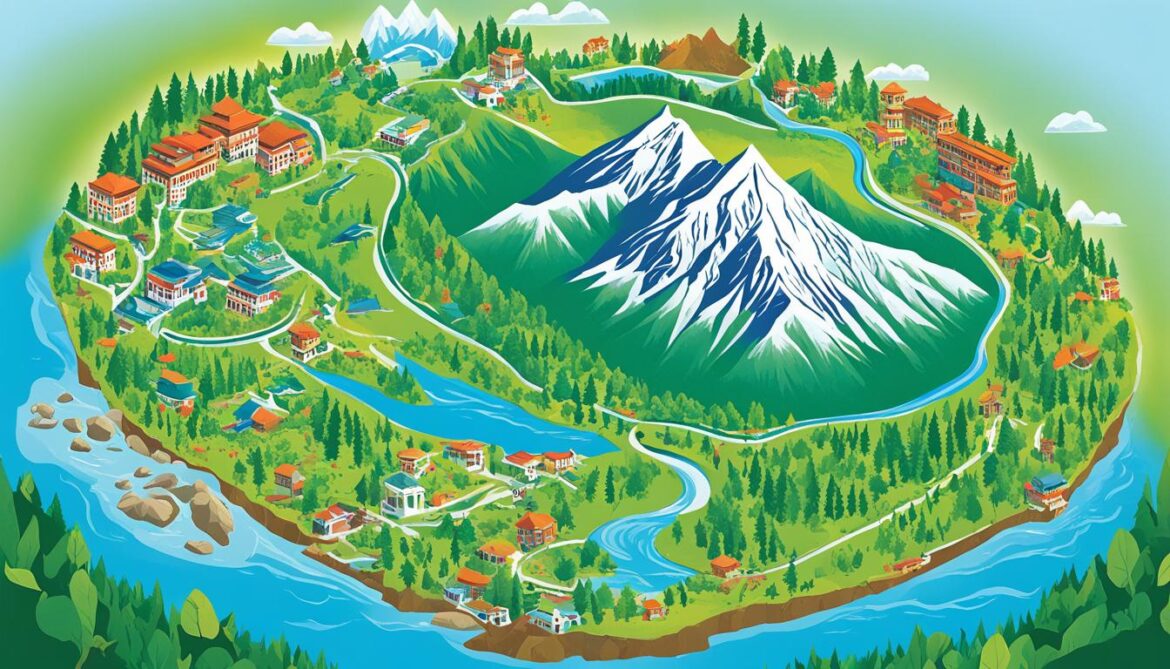Nepal Biodiversity and the Built Environment
Nepal, a country known for its breathtaking landscapes in the Himalayan region, holds a surprising statistic that highlights the scale of its remarkable biodiversity. With over 118 ecosystems and more than 35,000 plant and animal species, Nepal stands as one of the world’s biodiversity hotspots. The unique combination of geographical features and climatic conditions has created a haven for diverse flora and fauna.
Key Takeaways
- Nepal is renowned for its remarkable biodiversity, with over 35,000 plant and animal species.
- The country’s geographical features and diverse climatic conditions contribute to its rich biodiversity.
- Conserving Nepal’s biodiversity is crucial for the well-being of local ecosystems and the global environment.
- Sustainable architecture, green infrastructure design, and nature-based solutions play a vital role in preserving Nepal’s biodiversity.
- Ecosystem management and community-based conservation efforts are essential for the protection of endemic species in Nepal.
Nepal’s Unique Biodiversity Hotspots
Nepal, known for its breathtaking landscapes and rich cultural heritage, is also home to a unique and diverse range of flora and fauna. The nation is considered one of the biodiversity hotspots in the world, boasting an array of endemic species found nowhere else on the planet.
The mountainous regions of Nepal, particularly the subalpine and alpine zones, are renowned for their exceptional biodiversity. These areas experience a wide range of climatic and altitudinal variations, creating diverse ecosystems that support a multitude of plant and animal species.
Preserving these biodiversity hotspots is crucial not only to the survival of Nepal’s endemic species but also to the overall health of the planet.
Threats to Nepal’s Biodiversity
Nepal’s remarkable biodiversity is under threat from various factors that pose risks to its precious species and ecosystems. The key threats to Nepal’s biodiversity include habitat loss and deforestation, invasive species, and poaching and illegal wildlife trade.
Habitat loss and deforestation: The clearing of forests and the loss of natural habitats are significant concerns in Nepal. Factors such as forest fires, unsustainable agricultural practices, and the expansion of infrastructure contribute to the destruction of habitats, resulting in the displacement and endangerment of numerous species. This loss of habitat has a detrimental impact on the delicate balance of ecosystems and the survival of many plants and animals.
Invasive species: Invasive species pose a critical threat to Nepal’s biodiversity. These non-native species, introduced either intentionally or inadvertently, can rapidly spread and negatively impact native flora and fauna. Invasive plants, insects, and animals disrupt ecological balance, outcompeting native species for resources and causing irreversible damage to ecosystems.
Poaching and illegal wildlife trade: The demand for animal parts for traditional medicine, trophies, and exotic pets drives the illegal wildlife trade in Nepal. This illicit activity puts immense pressure on vulnerable populations of wildlife, pushing many species to the brink of extinction. Poaching, driven by the indiscriminate killing of animals for profit, particularly targets endangered species, further exacerbating the threat to Nepal’s biodiversity.

Conservation Efforts
Nepal has recognized the urgency of addressing these threats and has implemented various conservation efforts to protect its biodiversity. Through the establishment of protected areas and engaging in sustainable development practices, Nepal aims to create a balance between economic growth and safeguarding its natural treasures. Community-based management plays a crucial role in these conservation measures, with local communities actively participating in the protection and management of Nepal’s diverse ecosystems.
Major Threats to Nepal’s Biodiversity
| Threats | Description |
|---|---|
| Habitat Loss and Deforestation | Clearing of forests and loss of natural habitats due to forest fires, unsustainable agricultural practices, and infrastructure expansion |
| Invasive Species | Introduction of non-native species that disrupt ecological balance and cause damage to native flora and fauna |
| Poaching and Illegal Wildlife Trade | Demand for animal parts for traditional medicine, trophies, and exotic pets driving the illegal wildlife trade |
Conservation Efforts in Nepal
Nepal has demonstrated a strong commitment to conserving its diverse and precious biodiversity. The country has established 20 protected areas and 12 buffer zones, covering a significant portion of its total land area. These protected areas include national parks, wildlife reserves, conservation areas, hunting reserves, and buffer zones. By designating these areas, Nepal aims to safeguard its natural treasures and ensure the long-term survival of its unique ecosystems and species.
In addition to protected areas, Nepal has embraced sustainable development practices that promote a harmonious balance between economic growth and conservation efforts. Recognizing the importance of preserving its natural resources for future generations, Nepal has integrated sustainable development principles into its policies and initiatives.
One significant factor contributing to the success of conservation efforts in Nepal is community-based management. Local communities play a crucial role in the protection and management of natural resources in their respective areas. They actively participate in activities such as patrolling, monitoring, and raising awareness about the importance of conservation. This community engagement fosters a sense of stewardship and ownership among the people, leading to more effective and sustainable conservation outcomes.
“Conservation efforts in Nepal are driven by a strong sense of responsibility towards our natural heritage. Through the establishment of protected areas, sustainable development initiatives, and community-based management, we strive to ensure the preservation of our precious biodiversity for the benefit of present and future generations.”
The Impact of Protected Areas in Nepal
| Protected Areas | Land Area Coverage (%) | Key Features |
|---|---|---|
| National Parks | 12.53% | Preservation of critical habitats for flagship species |
| Wildlife Reserves | 5.86% | Protection of habitats for diverse wildlife |
| Conservation Areas | 2.85% | Conservation of unique ecosystems and cultural heritage |
| Hunting Reserves | 0.14% | Regulated hunting for sustainable resource management |
| Buffer Zones | 1.85% | Collaborative management between local communities and protected areas |
The establishment of protected areas has had a significant positive impact on biodiversity conservation in Nepal. These areas serve as sanctuaries for endangered species and critical habitats for a wide range of flora and fauna. They also contribute to the overall health and balance of ecosystems, ensuring the preservation of biodiversity on a larger scale.
Furthermore, protected areas act as educational and recreational spaces, attracting tourists and researchers from around the world. This generates revenue and opportunities for the local communities through sustainable tourism and eco-trekking activities, thus promoting both conservation and economic development.

The conservation efforts in Nepal are a testament to the country’s commitment to sustainable development and the preservation of its unique natural heritage. By prioritizing conservation, embracing sustainable practices, and involving local communities, Nepal aims to ensure a harmonious coexistence between humans and nature, paving the way for a greener and more resilient future.
Endangered Species in Nepal
Nepal is home to several endangered and critically endangered species, such as the one-horned rhino found in Chitwan National Park.
Conservation efforts in Nepal are focused on protecting these endangered species and their habitats through various measures. Some of these measures include raising awareness, implementing anti-poaching measures, and promoting sustainable tourism.
The conservation of endangered species is a collective responsibility that requires the active participation of governments, organizations, and individuals. By working together, we can make a significant impact in safeguarding Nepal’s precious biodiversity.
Efforts to protect the one-horned rhino population in Chitwan National Park have shown positive results, with their numbers gradually increasing over the years. However, continuous conservation efforts are necessary to ensure the long-term recovery of endangered species in Nepal.

Table: Conservation Status of Endangered Species in Nepal
| Species | Conservation Status |
|---|---|
| One-horned Rhino | Endangered |
| Snow Leopard | Endangered |
| Red Panda | Endangered |
| Bengal Tiger | Endangered |
| Gharial | Critically Endangered |
The table above highlights some of the endangered species in Nepal and their conservation status. These species are essential for maintaining the ecological balance and biodiversity of the region.
Unique Plant Species in Nepal
Nepal’s flora boasts an incredible diversity, showcasing a wide array of unique plant species. The country is especially renowned for its abundant collection of medicinal plants, which serve as invaluable resources for traditional medicine practices. One remarkable example is the esteemed yarshagumba (Cordyceps sinensis), a highly revered medicinal fungus known for its exceptional healing properties. Nepal is also home to numerous endemic plant species, exclusive to the region due to its distinct climatic and altitudinal variations. These plants hold significant cultural, economic, and ecological value, playing a pivotal role in sustaining local ecosystems.

Medicinal Plants in Nepal
Nepal’s rich biodiversity encompasses a wide range of plant species with medicinal properties. These plants have been utilized for centuries in traditional medicine practices to treat various ailments and promote well-being. From herbs and shrubs to trees and fungi, Nepal offers a treasure trove of medicinal flora. The knowledge surrounding the healing properties of these plants has been passed down through generations, and they continue to play a vital role in the healthcare practices of local communities.
Endemic Plant Species in Nepal
Nepal’s unique geographical features have given rise to a multitude of endemic plant species found exclusively within its borders. These plants have evolved and adapted to the distinct climatic conditions and altitudinal variations of the region. Endemic plant species hold immense ecological significance as they contribute to the overall biodiversity and ecological balance of Nepal’s ecosystems. Additionally, they play a significant role in preserving cultural traditions and are integral to the daily lives and livelihoods of local communities.
National Biodiversity Strategy and Action Plan
Nepal has developed a National Biodiversity Strategy and Action Plan (NBSAP) as a strategic framework for the conservation of its biodiversity. The NBSAP is designed to contribute to sound and resilient ecosystems, fostering national prosperity. As a signatory to the Convention on Biological Diversity, Nepal is committed to fulfilling its international obligations. The NBSAP serves as a comprehensive guide for planning and sustainable management of biological diversity across all sectors of the country.
This strategic framework provides a roadmap for Nepal to address the challenges and opportunities in preserving its unique biodiversity. By outlining clear objectives and targets, the NBSAP sets a conservation framework that aligns with international best practices and standards. It emphasizes the need for collaborative efforts and integrated approaches that involve various stakeholders, including government agencies, local communities, and civil society organizations.
“The National Biodiversity Strategy and Action Plan is a crucial tool for Nepal’s conservation efforts, guiding decision-making processes and ensuring the wise use and protection of our biological resources,” says Dr. Hari Bahadur Mahat, Minister for Forests and Environment.
Under the NBSAP, Nepal aims to enhance the conservation and sustainable use of its biodiversity. The plan provides a strategic direction for conserving ecosystems, species, and genetic resources while promoting sustainable practices that balance the needs of people and the environment. It also emphasizes the importance of raising public awareness, enhancing capacity building, and strengthening monitoring and evaluation mechanisms to ensure effective implementation.
Key Objectives of the National Biodiversity Strategy and Action Plan:
- Promote the conservation and sustainable management of biodiversity in all landscapes and ecosystems.
- Enhance the resilience of ecosystems and species to climate change and other stresses.
- Strengthen the capacity of institutions and communities to support biodiversity conservation and sustainable development.
- Ensure equitable sharing of benefits derived from biodiversity and traditional knowledge.
- Integrate biodiversity considerations into sectoral policies and development plans.
By prioritizing these objectives, Nepal aims to create a comprehensive and effective framework that addresses the diverse challenges faced in conserving and managing its unique biodiversity. Through the implementation of the NBSAP, Nepal is poised to fulfill its international obligations and contribute to global efforts in biodiversity conservation.

Nepal Biodiversity Strategy (Excerpt)
The Nepal Biodiversity Strategy underscores the commitment of the Government and people of Nepal towards the protection and management of our biological resources and their diversity. Through this strategy, we strive to achieve sustainable economic growth by harnessing the wise use of natural resources and adhering to principles of sound environmental management.
Central to the strategy is the safeguarding of ecological processes and systems that support and sustain our diverse ecosystems. We recognize the importance of preserving the delicate balance of nature and ensuring the perpetuation of vital biodiversity.
A key focus of the strategy is the equitable sharing of benefits derived from Nepal’s rich biodiversity. We believe that all individuals and communities should have access to and benefit from the sustainable utilization of our biological resources. By ensuring equitable sharing, we promote social justice, foster sustainable livelihoods, and protect the natural heritage of our nation.
The Nepal Biodiversity Strategy serves as a comprehensive guide for all stakeholders whose actions may impact the management of our unique biodiversity. By following the principles and objectives outlined in the strategy, we can collectively contribute to the preservation and sustainable use of Nepal’s precious natural resources.

“The Nepal Biodiversity Strategy highlights our commitment to protect our natural heritage and ensure the sustainable utilization of our biological resources for the benefit of present and future generations.”
Executive Summary (Excerpt)
The executive summary of the Nepal Biodiversity Strategy outlines the goals and outcomes of the strategy. The strategy is a commitment to the protection and wise use of Nepal’s biologically diverse resources for the benefit of its people and the global community. It emphasizes the importance of political commitment, information management, human and institutional capacity, policies and legislation, public awareness, and monitoring and evaluation in achieving the goals of the strategy. The strategy has been developed through extensive consultations with stakeholders from various sectors of society.
Conclusion
Nepal’s rich biodiversity and its commitment to conservation efforts highlight the country’s ecological importance. The presence of unique flora and fauna, including endemic species found exclusively in Nepal, showcases the remarkable diversity of its natural heritage. Through dedicated conservation initiatives, community engagement, and sustainable development practices, Nepal has made significant strides in protecting its biodiversity and preserving its unique ecosystems.
However, the threats to Nepal’s biodiversity remain significant, necessitating ongoing efforts to mitigate these challenges. Habitat loss, deforestation, invasive species, and illegal wildlife trade continue to pose risks to the country’s fragile ecosystems. To ensure a sustainable future, Nepal must continue embracing nature-based solutions, ecological building practices, and sustainable urban planning.
By incorporating these principles into the development of its built environment, Nepal can strike a harmonious balance between human progress and environmental preservation. This approach not only promotes healthier living but also contributes to global conservation efforts, positioning Nepal as a leader in sustainable development.








